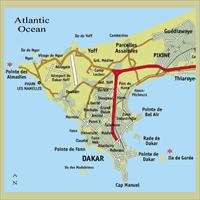SENEGAL: Thousands displaced from their Dakar homes

Thousands of people have been displaced from their homes in two districts of Dakar where houses should never have been built, according to Seydou Sysall, the former Senegalese minister of development and urban planning.
The two districts are Guédiawaye and Pikine, both of which are in coastal wetland zones. Particularly affected is the neighbourhood of Wakhinane Nimzatt, which means “dig and drink” in the local language Wolof.
“Building on wetlands exacerbates the flood situation”, said Sysall. “These wetlands are not viable for construction.”
According to the International Federation of the Red Cross and Red Crescent (IFRC), 600 families are affected in Guédiawaye.
The government promised to re-house these victims but many said they were still waiting for a new home and had to rent or live with relatives.
“We are still waiting for people to move us and give us a new house. But we know there are limited resources, so for now we are obliged to stay here [in rented accommodation],” Ndeyene Diouf, a resident of Wakhinane Nimzatt, told IRIN.
Wetlands are areas where the water table is at or near the surface of the land, or where the land is covered by shallow water.
Reservoirs
Four reservoirs have been built to drain ground water from Pikine and Guédiawaye. Between them they hold 1.4 million cubic metres of water. Four more are planned for other flood-prone Dakar suburbs, said Mansour Ndoye, an official at the Ministry of Urban Planning.
However, the reservoirs need to be made properly watertight, said Councilor Ngom, a local municipal councilor in Wakhinane Nimzatt. The plan is to equip them with pumps so that water can be pumped out of the reservoirs into the sea if it looks like they might burst their banks, he said.
Delays in finishing the reservoirs have contributed to this year’s Guédiawaye flooding. “Unfortunately the reservoirs are not finished so now, each time it rains, water overflows and floods nearby houses,” said Ngom.
“We are a little behind schedule… The problem is that some people refuse to leave their homes, which delays work on the reservoirs,” Ndoye said.
Ngom confirmed that some people were refusing to leave their homes, using buckets to empty their houses of water.
Flooding is an annual problem in suburban wetlands areas, according to Sysall, but, he said, “the problem is not the rain; the problem is constructing [houses] on wetlands.”
Government ban
The government issued a ban on construction in wetland zones in its 1967 Dakar Urban Plan, which has not been updated or enforced in over 40 years, according to Councilor Ngom.
“The law says [wetlands] should not be built on, but people do it anyway,” Sysall told IRIN.
After particularly heavy rain in 2005 the government launched the five-year Plan Jaxaay, which means “Eagle” committing US$107 million to build housing for families displaced by flooding in wetland areas, and building up the infrastructure and sanitation systems to make the sites less vulnerable to flooding.
Since then, 1,500 families have been moved to districts outside Dakar, according to Ndoye, who is also an assistant coordinator of Plan Jaxaay.
The rural exodus to Dakar has contributed greatly to the flood problem, as newcomers build houses illegally, but the government is planning a tougher stance: “We are reactivating this law and will make sure from now on that people are removed from wetland areas,” he told IRIN.
 Back and Next - Back and Next
Back and Next - Back and Next See Also - See Also
See Also - See Also